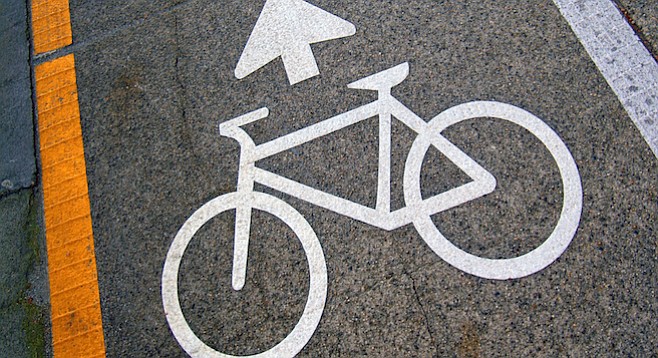 Facebook
Facebook
 X
X
 Instagram
Instagram
 TikTok
TikTok
 Youtube
Youtube

No one responded to more than 1600 flyers hung on doors near the Landis Street Bike Lane project that announced a community meeting on March 9.
In preparing for the meeting, a contractor hired by the San Diego Association of Governments put door hangers on every home and business within 75 feet of Landis Street and 300 feet from every intersection, reaching deep into the adjoining streets. But of the 32 people who signed in (about 40 attended the meeting) nearly all indicated that they'd heard about the meeting via SANDAG's email lists.
The project meeting was also promoted via Twitter and through ads in CityBeat and this publication.
A bike commuter who would only give his first name criticized the ineffectual outreach while praising the project. "In City Heights, there's a recognition that SANDAG doesn't listen to us in terms of letting the community be involved in the planning," Alex said. "People are mostly supportive of this."
A frustration mentioned by several attendees is that planning, funding, and implementing a project that would make things safer and easier for pedestrians and bicyclists takes so long.
"It's a good project, “ said Randy Van Vleck, active transportation manager for the City Heights Community Development Corp. "This project will create a safer environment for people who walk, people who bike, and people who drive."
Planners put up more than a dozen large storyboards showing segments of the project that is intended to run from Alabama Street to Fairmount Avenue. It is marked by a narrowing of lanes to create bike lanes, roundabouts instead of stop signs, bulb-out intersections, crosswalks that narrow the vehicle lanes, and new, beefed-up striping of crosswalks.
Association of governments staff promised to put the block-by-block details on their website so people can comment there as well. Planners gathered dozens of comments suggesting minor tweaks along the route — and some community activists asked about a once-planned bridge across the I-15 that had been too costly to build.
Planners will now consider the input and bring updated designs back to meetings in the future, Kluth said.


No one responded to more than 1600 flyers hung on doors near the Landis Street Bike Lane project that announced a community meeting on March 9.
In preparing for the meeting, a contractor hired by the San Diego Association of Governments put door hangers on every home and business within 75 feet of Landis Street and 300 feet from every intersection, reaching deep into the adjoining streets. But of the 32 people who signed in (about 40 attended the meeting) nearly all indicated that they'd heard about the meeting via SANDAG's email lists.
The project meeting was also promoted via Twitter and through ads in CityBeat and this publication.
A bike commuter who would only give his first name criticized the ineffectual outreach while praising the project. "In City Heights, there's a recognition that SANDAG doesn't listen to us in terms of letting the community be involved in the planning," Alex said. "People are mostly supportive of this."
A frustration mentioned by several attendees is that planning, funding, and implementing a project that would make things safer and easier for pedestrians and bicyclists takes so long.
"It's a good project, “ said Randy Van Vleck, active transportation manager for the City Heights Community Development Corp. "This project will create a safer environment for people who walk, people who bike, and people who drive."
Planners put up more than a dozen large storyboards showing segments of the project that is intended to run from Alabama Street to Fairmount Avenue. It is marked by a narrowing of lanes to create bike lanes, roundabouts instead of stop signs, bulb-out intersections, crosswalks that narrow the vehicle lanes, and new, beefed-up striping of crosswalks.
Association of governments staff promised to put the block-by-block details on their website so people can comment there as well. Planners gathered dozens of comments suggesting minor tweaks along the route — and some community activists asked about a once-planned bridge across the I-15 that had been too costly to build.
Planners will now consider the input and bring updated designs back to meetings in the future, Kluth said.
Comments